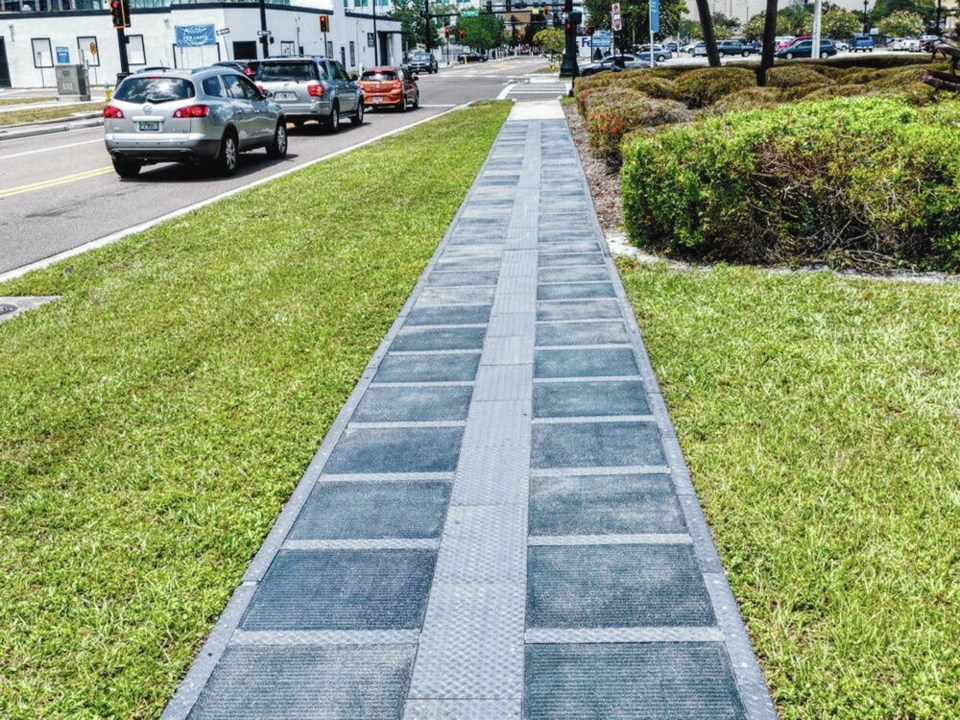Destroyed by wildfire last June a day after setting a national heat record of 49.6 degrees Celsius, the village of Lytton could become a community of the future.
The fire-ravaged village, about 190 kilometres northeast of Whistler, is planning to rebuild as a net-zero emissions community. To help achieve this, council is planning to power the village using a new technology called solar sidewalks made by a Vancouver company.
Solar Earth Technologies makes solar panels that not only generate electricity to power homes but can withstand the weight of a five-ton vehicle or, according to company director and CEO Douglas Matthews, a stomping elephant. The hardened solar panels can be fitted into sidewalks, trails, bike paths, driveways and parking lots.
“Our goal is help Lytton create a net-zero community. If we put our infrastructure down for their sidewalks, we could produce enough power to make the entire town net-zero,” said Matthews in an interview.
He said the solar sidewalks, which look similar to a regular sidewalk, are also skid-proof and have been tested to endure weather.
“We’ve got some key partners that we work with that make them safe, so that people can still walk and bike and not slip and fall,” he said. “It has a traction layer built on top of it so that it’s not slippery when wet.”
As for fire, Matthews said they are tested for internal flammability and are designed to operate from -40 C to 90 C ground temperature, but they likely wouldn’t be spared in another extreme wildfire.
“The Lytton fire was so extreme it even impacted steel and our modules would not have fared better,” he said, adding that the goal is to reduce fossil-fuel emissions to avoid more catastrophes in the future.
Thompson Rivers University in Kamloops, and Tampa, Florida, are already using Solar Earth’s power-generating sidewalks, and they have installed some in China and South Africa, said Matthews, who hopes other communities will follow Lytton in striving for net-zero emissions using solar powered sidewalks.
Matthews said a driveway with a solar sidewalk installed could provide enough power for an entire house, and can charge an electric vehicle. “We’ve done enough studies to show that if we just convert hard landscapes to energy-producing environments, the need for fossil fuels goes down dramatically,” he said.
On B.C.’s south coast there can be cloudy and rainy days for a week or more at a time, but Matthews said the sidewalks can operate for five days without sunlight. After that, there would need to be a backup plan, such as switching back to the power grid.
Lytton Mayor Jan Polderman was in Metro Vancouver this week to view the solar sidewalk panels. He said approval has gone through council and they have a memorandum of understanding with the company to go ahead with the plan, but they are still working out the details such as how much of the village will be powered by the sidewalks.
He did not have a cost for the project but said a preliminary estimate is around $500,000 per kilometre. Going off the grid will save some of that money, and solar is considered a cleaner energy than hydro.
On Thursday, the B.C. government announced Lytton would receive an additional $21 million to help it rebuild essential infrastructure and services. The funds will also go to rebuilding municipal structures and assessing water and sewer infrastructure, and is in addition to almost $28 million in provincial funding announced earlier this year.
Polderman said the village hopes to have all wildfire debris cleaned up by the end of September, with rebuilding possibly beginning next year.



